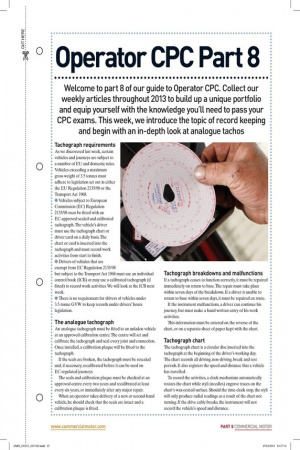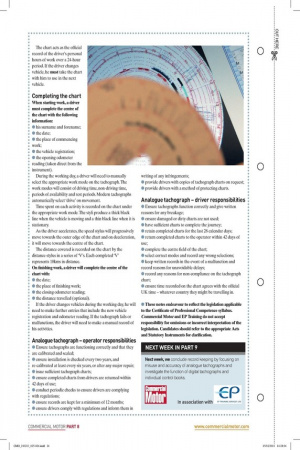erator CPC Part 8
Page 19

Page 20

If you've noticed an error in this article please click here to report it so we can fix it.
Welcome to part 8 of our guide to Operator CPC. Collect our weekly articles throughout 2013 to build up a unique portfolio and equip yourself with the knowledge you'll need to pass your CPC exams. This week, we introduce the topic of record keeping and begin with an in-depth look at analogue tachos Tachograph requirements As we discovered last week, certain vehicles and journeys are subject to a number of EU and domestic rules. Vehicles exceeding a maximum gross weight of 3.5 tonnes must adhere to legislation set out in either the EU Regulation 2135/98 or the Transport Act 1968.
• Vehicles subject to European Commission (EC) Regulation 2135/98 must be fitted with an EC-approved sealed and calibrated tachograph. The vehicle's driver must use the tachograph chart or driver card on a daily basis. The chart or card is inserted into the tachograph and must record work activities from start to finish.
• Drivers of vehicles that are exempt from EC Regulation 2135/98 but subject to the Transport Act 1968 must use an individual control book (ICB) or may use a calibrated tachograph (if fitted) to record work activities. We will look at the ICB next week.
• There is no requirement for drivers of vehicles under 3.5-tonne GVVV to keep records under drivers' hours legislation.
The analogue tachograph An analogue tachograph must be fitted to an unladen vehicle at an approved calibration centre. The centre will set and calibrate the tachograph and seal every joint and connection. Once installed, a calibration plaque will be fitted to the tachograph.
If the seals are broken, the tachograph must be resealed and, if necessary, recalibrated before it can be used on EC-regulated journeys.
The seals and calibration plaque must be checked at an approved centre every two years and recalibrated at least every six years, or immediately after any major repair.
When an operator takes delivery of a new or second-hand vehicle, he should check that the seals are intact and a calibration plaque is fitted.
Tachograph breakdowns and malfunctions If a tachograph ceases to function correctly, it must be repaired immediately on return to base. The repair must take place within seven days of the breakdown. If a driver is unable to return to base within seven days, it must be repaired en route.
If the instrument malfunctions, a driver can continue his journey, but must make a hand-written entry of his work activities.
This information must be entered on the reverse of the chart, or on a separate sheet of paper kept with the chart.
Tachograph chart The tachograph chart is a circular disc inserted into the tachograph at the beginning of the driver's working day. The chart records all driving, non-driving, break and rest periods. It also registers the speed and distance that a vehicle has travelled.
To record the activities, a clock mechanism automatically rotates the chart while styli (needles) engrave traces on the chart's wax-coated surface. Should the time-clock stop, the styli will only produce radial readings as a result of the chart not turning. If the drive cable breaks, the instrument will not record the vehicle's speed and distance.
The chart acts as the official record of the driver's personal hours of work over a 24-hour period. If the driver changes vehicle, he must take the chart with him to use in the next vehicle.
Completing the chart When starting work, a driver must complete the centre of the chart with the following information: • his surname and forename; • the date; • the place of commencing work; • the vehicle registration; • the opening odometer reading (taken direct from the instrument).
During the working day, a driver will need to manually select the appropriate work mode on the tachograph. The work modes will consist of driving time, non-driving time, periods of availability and rest periods. Modern tachographs automatically select 'drive' on movement.
Time spent on each activity is recorded on the chart under the appropriate work mode. The styli produce a thick black line when the vehicle is moving and a thin black line when it is stationary.
As the driver accelerates, the speed stylus will progressively move towards the outer edge of the chart and on deceleration, it will move towards the centre of the chart.
The distance covered is recorded on the chart by the distance stylus in a series of V's. Each completed 'V' represents 10kms in distance.
On finishing work, a driver will complete the centre of the chart with: • the date; • the place of finishing work; • the closing odometer reading; • the distance travelled (optional).
If the driver changes vehicles during the working day, he will need to make further entries that include the new vehicle registration and odometer reading. If the tachograph fails or malfunctions, the driver will need to make a manual record of his activities.
Analogue tachograph - operator responsibilities • Ensure tachographs are functioning correctly and that they are calibrated and sealed; • ensure installation is checked every two years, and re-calibrated at least every six years, or after any major repair; • issue sufficient tachograph charts; • ensure completed charts from drivers are returned within 42 days of use; • conduct periodic checks to ensure drivers are complying with regulations; • ensure records are kept for a minimum of 12 months; • ensure drivers comply with regulations and inform them in writing of any infringements; • provide drivers with copies of tachograph charts on request; • provide drivers with a method of protecting charts.
Analogue tachograph - driver responsibilities • Ensure tachographs function correctly and give written reasons for any breakage; • ensure damaged or dirty charts are not used; • have sufficient charts to complete the journey; • retain completed charts for the last 28 calendar days; • return completed charts to the operator within 42 days of use; • complete the centre field of the chart; • select correct modes and record any wrong selections; • keep written records in the event of a malfunction and record reasons for unavoidable delays; • record any reasons for non-compliance on the tachograph chart; • ensure time recorded on the chart agrees with the official UK time — whatever country they might be travelling in.
• These notes endeavour to reflect the legislation applicable to the Certificate of Professional Competence syllabus. Commercial Motor and EP Training do not accept responsibility for omissions or incorrect interpretation of the legislation. Candidates should refer to the appropriate Acts and Statutory Instruments for clarification.









































